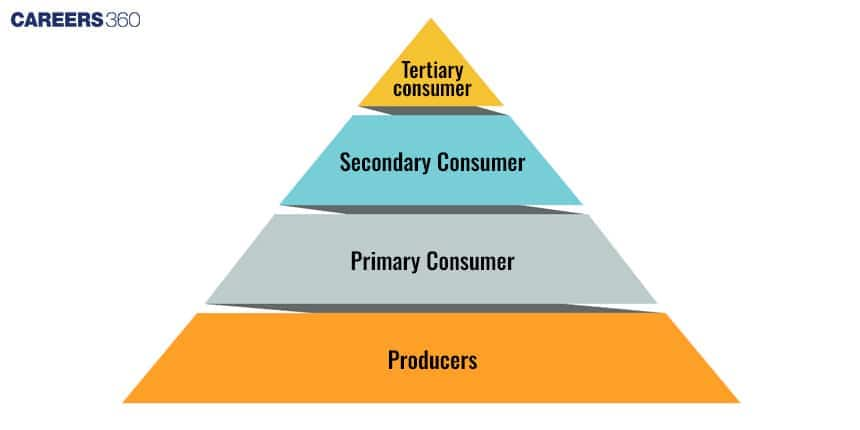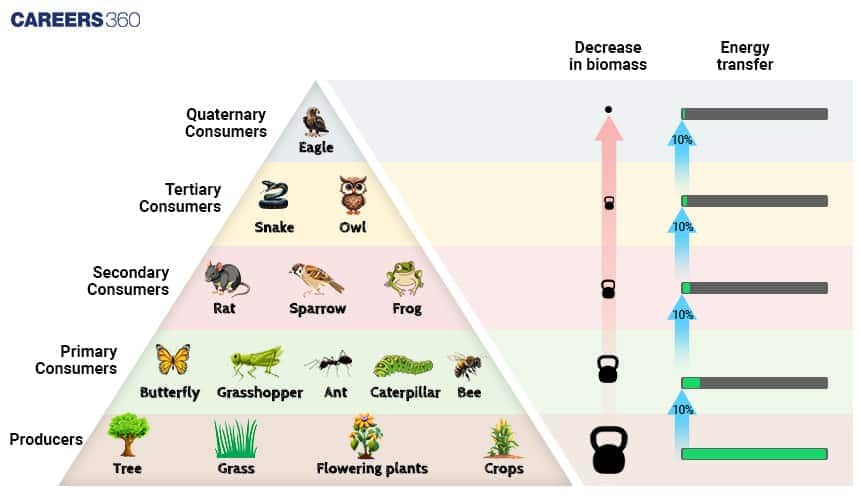Energy Flow in Ecosystem - Definition, Process, and Importance
Energy flow through ecosystems refers to the movement of energy from one trophic level to another within a food chain, but always starts from the primary source of energy, the Sun. It is according to the laws of thermodynamics, in which energy may change forms but is lost partly as heat at each level. Only a portion (10%) of the energy is transferred to the next level, as shown in energy flow diagrams or pyramids. This is an important part of the Ecology unit in Biology.
NEET 2025: Mock Test Series | Syllabus | High Scoring Topics | PYQs
NEET Important PYQ's Subject wise: Physics | Chemistry | Biology
New: Meet Careers360 B.Tech/NEET Experts in your City | Book your Seat now
- Definition of Energy Flow in Ecosystems
- The Basics of Energy Flow
- Trophic Level and Food Chain
- Energy Pyramids
- Laws of Thermodynamics in Ecosystems
- Energy Transfer Efficiency

Definition of Energy Flow in Ecosystems
The flow of energy in ecosystems is how energy moves from the primary producers, such as the plants, to various consumers including herbivores, carnivores, omnivores, and decomposers. It is the process that provides the model for the energy flow in ecosystems, which is necessary for the structure and functions of ecosystems.
A Sun provides the source of energy and it follows the food chain through its various trophic levels. The single-channel energy flow model describes this movement as unidirectional, with a continuous decrease in energy at each level due to the law of thermodynamics.
The energy flow of ecosystems is useful to explain energy dynamics, the role of organisms, nutrient cycling, and the changes in the environment. The issues of ecological challenges such as climatic change and habitat destruction can also be addressed with the increase in biodiversity conservation. Energy flow is often represented using diagrams and notes, hence it becomes a very important concept in Class 9 and 10 ecosystem studies.
Also Read:
The Basics of Energy Flow
All energy in ecosystems has to start with very basic or primary sources of energy fueling the wholeness of a food web.
Sources of Energy
The sun serves as the source of most energy within ecosystems.
Solar energy captured by plants, algae, and some bacteria through photosynthesis forms the base of the food chain.
Most of the energy in such systems as deep-sea hydrothermal vents is in chemical form.
Chemosynthetic bacteria convert inorganic compounds into organic matter, supporting unique ecosystems, like deep-sea hydrothermal vents, using hydrogen sulfide.
Energy Conversion
Photosynthesis is a process whose role is highly crucial in energy flow among the ecosystems. It involves the conversion of solar energy, carbon dioxide, and water into glucose and oxygen by green plants, algae, as well as some bacteria.
This energy stored in chemical form forms the basis of energy flow, en route to energy transfer along the food chain as well as the foundation of the energy flow model in the ecosystems. This process can be represented in energy flow diagrams to show the movement of energy starting with producers. The next important energy flow mechanism is chemosynthesis, in which specific bacteria build organic compounds using energy derived from chemical reactions, often sulfur or methane compounds. It is an important mechanism in the absence of sunlight, by deep-sea hydrothermal vents.Trophic Level and Food Chain
Trophic levels refer to the hierarchical stages in a food chain concerning various nutrition levels at which organisms transmit energy and nutrients. Producers will, therefore, be the lowest, while the top predators take the highest level.
Producers (Autotrophs)
These are organisms that make their food either from sunlight-photosynthesis- or chemical energy chemosynthesis. Producers are the base of the food chain.
Examples: Plants, algae, and some bacteria.
Primary Consumers (Herbivores)
Herbivores ingest producers and get their energy directly from plants or algae.
Examples: Rabbits, deer, and caterpillars.
Secondary Consumers (Carnivores or Omnivores)
These offer another level of consumers feeding on primary customers, thereby transferring their energy higher up through the food chain.
Examples: Lions—carnivores, humans—omnivores.
Tertiary Consumers
The next higher trophic level steps from the secondary consumer many are top predators.
Examples: Hawks, sharks.
Quaternary Consumers
Apex predators at the top of a food chain, preying on the tertiary consumers.
Examples: Orcas, large predators such as polar bears.
Decomposers (Detritivores)
Decomposers break down dead material and return nutrients to the system, which is important to keep an ecosystem fit and healthy.
Examples: Fungi, bacteria, earthworms.
Types of Food Chains in Ecosystems
Three main types of food chains are there for energy flow in ecosystems and its movement through different trophic levels:
Grazing Food Chain (GFC): This is the most common type of energy flow in food chains. It starts with plant producers, herbivores-primary consumers, carnivores-secondary consumers, and higher-level consumers. This kind of energy flow can be considered to follow the model set for ecosystems and often flows into representation in energy flow diagrams.
The Saprophytic or Detritus Food Chain: This is composed of dead organic matter, and therefore it constitutes the base, energy flows to the decomposers like fungi and bacteria and continues trophically. This kind of food chain type shows the role played by decomposers in the cycling of nutrients and energy dynamics in ecosystems.
Parasitic Food Chain (PFC): In this chain, the larger organisms whether producers or consumers, are exploited by the smaller organisms such as parasites. The energy flow goes from the host organism to the parasites as an altogether different interaction within the ecosystem.
Energy Pyramids
Energy pyramids refer to a graphical representation that shows the energy flow in ecosystems by depicting the amount of energy or matter that occurs at different trophic levels. This explains the energy dynamics and how it is converted in a step-down manner in the food chain.
Pyramid of Numbers
It represents the amount of organisms in each trophic level that exist in an ecosystem. It has a trend where one moves with decreasing numbers in higher levels. For example, given a grassland ecosystem, the number of producers is very high, like grasses, while the number of primary consumers, for example, rabbits, is lower.
The number of tertiary consumers, for example, hawks, is even smaller. It thereby shows the need for energy flow and the use of the food chain as a way of sustaining the balance of an ecosystem.The diagram represents the pyramid of the number

Pyramid of Biomass
The biomass pyramid represents the total mass of living organisms at each trophic level at a given time. Biomass usually decreases as energy moves up the levels due to the law of thermodynamics.
In this sense, a given forest ecosystem has some high biomass producers like trees whereas herbivorous animals such as deer and their main predators, wolves have much lower biomass. This is a model important for explaining energy flow in the ecosystem diagrams.
Pyramid of Energy
The energy pyramid focuses on the flow of energy through the trophic levels during a specific period. It emphasizes that only about 10% of energy is transferred to the next level, with the rest lost as heat.
In an aquatic ecosystem, for example, phytoplankton (producers) capture solar energy, which is transferred to zooplankton (primary consumers), then to fish (secondary consumers), and finally to apex predators like sharks. This helps learn models of energy flow in ecosystems, energy flow in a food chain, and energy dynamics in an ecosystem.The diagram shows the energy pyramid

Laws of Thermodynamics in Ecosystems
The laws of thermodynamics provide a fundamental framework for understanding energy flow and transformation in ecosystems.
First Law of Thermodynamics (Conservation of Energy)
Energy cannot be created or destroyed but only changed from one form to another. In ecosystems, this is manifest as solar energy is converted into chemical energy in the process of photosynthesis. That chemical energy afterwards moves through different trophic levels by consumption.
For example, plants convert sunlight into glucose. Herbivores consume plants and in turn, convert that energy into kinetic energy for locomotion and metabolic processes. Conversely, carnivores attain food through consuming herbivores.
Second Law of Thermodynamics (Entropy)
The second law deals with energy flow, in that the transfer of energy increases the disorder, hence increasing the entropy of a system, and there is always some energy lost as heat in any such transfer. In the case of ecosystems, this is observed in the flow of energy upwards through trophic levels, where only about 10% of the energy is transferred to the next level and the rest is lost, mainly as heat produced during respiration and metabolic activities.
It's because of this loss of energy as heat that energy pyramids generally show a decrease in available energy moving up the trophic levels. This, in turn, limits just how many higher-level consumers an ecosystem can support.
Energy Transfer Efficiency
It is an important function of energy flow in ecosystems that affects the energy dynamics and structure in an ecosystem. It describes how energy flows through the trophic levels and influences the overall functioning of an ecosystem.
10% RuleThe 10% rule simply means that only about 10% of the energy is transferred from one trophic level to the next. For example, primary consumers obtain only 10% of the energy stored by producers, and secondary consumers receive just 10% of the energy from primary consumers. This low transfer efficiency, depicted in energy flow diagrams, limits the number of trophic levels an ecosystem can support, making it a basic notion in explaining food chain energy flow and energy flow models of ecosystems.
Energy LossMost of the energy that is lost occurs during respiration, growth, and reproduction. This energy is in the form of heat and is emitted into the surroundings. This loss of energy at each trophic level, in turn, decreases the energy available at each successive trophic level. In this way also, it satisfies the law of thermodynamics.
Also Read
Frequently Asked Questions (FAQs)
The energy flow through an ecosystem refers to the transfer of energy from one trophic level to another. This starts with the primary producers like plants, flow through various consumers and decomposers, and keeps the structure and function going on in the ecosystem.
Energy transfer through trophic levels occurs when organisms consume each other, from producers or plants down to primary consumers like herbivores, then to the next, secondary and tertiary consumers as carnivores or omnivores, and finally to decomposers.
The 10% rule states that only about 10 per cent from one trophic level will make it through to the next; thus, 90 per cent is lost as heat through metabolic processes, respiration, and other activities.
Energy pyramids depict the amount of energy available at each subsequent trophic level algebraically becoming less than the previous one, hence showing the inefficiency of energy transfer and thus clearly explaining why fewer top-level predators exist than producers.
The first law of thermodynamics (conservation of energy) demonstrates that, in ecosystems, energy undergoes transformation and is neither created nor destroyed. The second law, about entropy, details how at every trophic level, there is energy loss in the form of heat, so less is potentially available for higher levels.
Human activities disrupt energy flow in an ecosystem in the following ways: through impairment of the availability of energy sources, change of food webs, and less efficient energy transfers.
Also Read
29 Nov'24 01:08 PM
25 Nov'24 08:54 AM
21 Nov'24 03:53 PM
21 Nov'24 01:52 PM
15 Nov'24 02:15 PM
14 Nov'24 09:05 AM
14 Nov'24 08:45 AM
13 Nov'24 10:19 PM